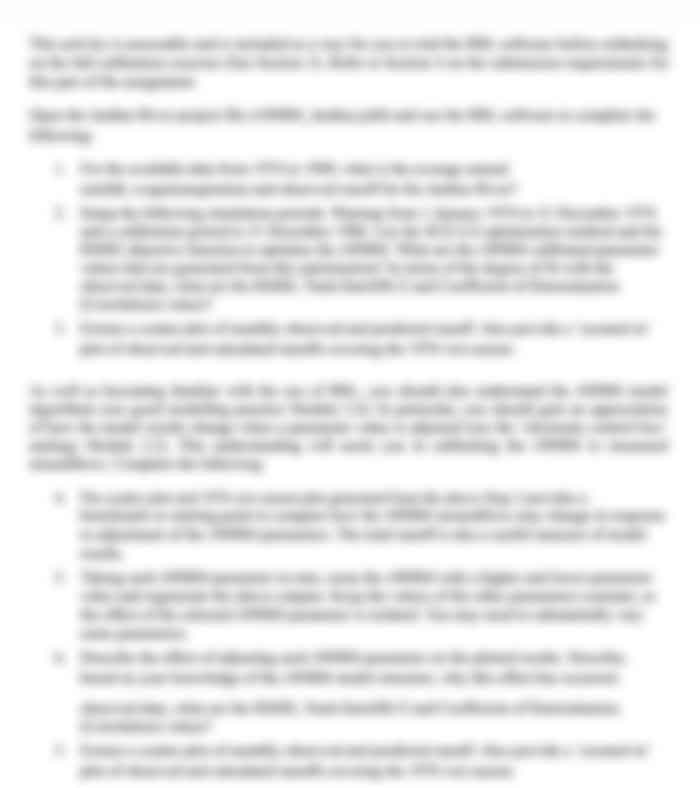Engineering Simulation -PDE4905 Assignment
- Subject Code :
PDE4905
Task 1 Simple Linear Programming and Optimisation (20 Marks)
A small factory has two products (A and B). Each product A costs $(80-a) to produce, and each product B costs$(60-b) to produce (where a and b are the last digits of your student number, respectively). The total costs mustbe less than $5000 as the budget each day. In addition, the market regulations require that the number of productB cannot exceed twice the number of product A, subject to the extra requirement that the number of each productmust be under 50 units per day.Each product A gives a profit of $40 and each product B gives a profit of $60. Design a simple daily productionportfolio (in terms of the numbers of Products A and B to be produced) so that the total profit is maximized.
Write this problem as a simple linear programming problem with the objective and all appropriateconstraints.
Find its optimal solution by solving it using two different methods (e.g., graphical method and ExcelSolver/Matlab).
If the factory wants to increase its profit by 20%, please advise what should be done to achieve this?[Hint. You can try to increase the budget, if so, by how much?]
If you cannot obtain integer solutions, please briefly discuss the reason and how to modify the formulateso that you can obtain integer solutions (the numbers of units of both products must be integers). If youcan obtain the integer solutions in the first place, also explain why it is the case.
Task 2 Choose one from two options (either 2a or 2b)
(2a) Transportation/Resource Allocation [25 Marks]
A product has 4 suppliers (A, B, C, D) that produce a total of 2000 units. All the units produced should bedistributed to 6 demand stations/customers (P, Q, R, S, T, W). The ransportation costs for transporting one unitfrom a supplier to a station are given in the following table:
.png)
Thus, its transportation cost matrix is simply
.png)
where a, b, c, d, e, and f are the single digits of your student number in the format M00abcdef. For
example, if your number is M00152379, you have a=1, b=5, c=2, d=3, e=7 and f=9.
.png)
Write down the mathematical formulation for this problem with the objective and all relevantconstraints and discuss their meaning briefly.
Solve the problem using either Excel Solver or Matlab/Octave to find its optimal solution. Check if the solution can indeed satisfy all the constraints.
(2b) Supermarket Staff Scheduling (25 Marks)
A busy supermarket is open 24 hours daily. It has a set of 20 checkout counters, though the actual number ofcheckouts needed ranges from 3 to 20, depending on the time of day. The number of staff needed to provide asatisfactory service varies at different hours as summarized in the following Table:
.png)
The supermarket employs 15 full-time staff and a large number of part-time staff. Part-time staff typically canwork a 6-hour shift every day and can start on the hour between 9:00 am to 1:00 pm, or at 3:00 pm, 6:00 pm,9:00 pm or 3:00 am.
Full-time staff work at most 40 hours per week between 9:00 am to 5:00 pm with a daily wage of 110 for 8hours per day, while part-time workers are paid at a standard rate of 10 per hour (i.e., 60 per day for 6 hours).The company policy only permits that up to 75% of the total working hours of any day to be part-time hours.The main task is to schedule the staff so that the total staff costs are minimized on a daily basis.
Formulate the scheduling problem in terms of a linear programming problem with a correct objectiveand all appropriate constraints. Explain in detail why your mathematical formulation is appropriate,
including any assumptions that you may have used.
Solve your staff scheduling problem using either Excel Solver or Matlab (intlinprog)/Octave (glpk).Summarize your solution procedure (including screenshots if appropriate) and present the main resultswith a brief discussion.
Check if all the required numbers of counters are met.
Task 3 Manufacturing Portfolio (30 Marks)
An engineering tooling manufacturer has 4 products: machining tables, tooling sets, testing tools, andstorage boxes. A machining table takes 8 hours to produce with the material cost of 80. A tooling settakes 6 hours to make with the material cost of 20. A testing tool takes 4 hours to make with thematerial cost of 25. A storage box takes 2 hours to make with the material cost of 10. Each week,there are 800 hours available with a weekly budget of 4000 for material costs. To make maintaindiversity of the products, the company will produce at least 5 units for each product.
A machining table typically comes with a tooling set. Thus, the number of tooling sets should be atleast 3 times the total number of machining tables and testing tools. Some customers may also wish tobuy a storage box if they buy a tooling set. Thus, the number of storage boxes should not exceed thenumber of tooling sets.The profits per unit are 250, 100, 150, and 60 for machining tables, tooling sets, testing tools,storage boxes, respectively. The main objective is to organize the production portfolio so as to
maximize the profit of the company on a weekly basis.
a) Formulate this problem as an LP with the objective and all the appropriate constraints.b) Solve the LP and find the maximum profit and discuss your result.
c) The company seems to do well, so it decides to hire more people (thus more available hours)with the same material cost budget. If the number of available hours is now 1000, will it affectthe production portfolio? Should the company recruit more people? Discuss and explain.
d) Another strategy is to increase the budget for raw materials. If the company intends to increaseits profit by 15%, subject to the condition that the available number of hours remainsunchanged, what is the new budget for raw material? Will the increase in the budget of raw
materials lead to the 15% increase in profit? Discuss your findings.
e) The company later realizes that the testing tools do not sell well, so it may consider not toproduce any testing tools at all. Will this potential change increase or decrease the profit
(assuming that the other conditions remain the same)? Discuss and explain briefly.
Task 4 Simulink (25 Marks)
Based on the Simulink model for a single motor you have built in class, now we have two identicalmotors that are attached to two light bars as two arms to form a simple robotic arm model (see Fig. 1).
Both arms have the same length of 500 mm. The two arms can rotate independently, and you cancontrol each motor individually with the same or different voltages.
For simplicity, you can use the same parameters that you have used in class, and you can also ignorethe masses of the two light robot arms (thus no change in the moment of inertia).
Build a Simulink model to simulate the robotic arm rotation. [Hint. You can use the model youhave built in class as the basis for extending the model functions.]
Rotate Arm 1 by 45oand rotate Arm 2 by 90o, change your model parameters (e.g., feedbackand/or voltage) to achieve the desired rotation angles. Sketch the response curves.
Discuss how to rotate Arm 1 by -90oand rotate Arm 2 by +90o? What is the Cartesian locationof point B (assuming the base of Motor 1 as the origin)? Show your response curves.
Point A will move on a circle of radius R=500 mm. Discuss the shape or domain that point Bcan cover by moving both motors. If point B is constrained within a rectangular region from
[-500,250] to [+500, +250], is it possible to achieve this. If yes, how? If not, why not?Discuss briefly (no more than half a page).
.png)

